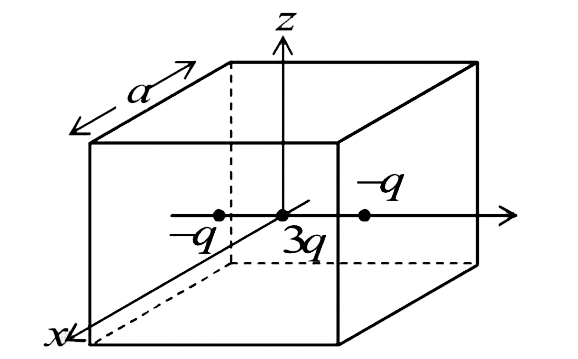A cubical region of side a has its centre at the origin. It encloses three fixed point charges, at , at and at . Choose the correct options(s)

The net electric flux crossing the plane is equal to the net electric flux crossing the plane
The net electric flux crossing the plane is more than the net electric flux crossing the plane
The net electric flux crossing the entire region is
The net electric flux-crossing the plane is equal to the net electric flux crossing the plane
Step by step video & image solution for A cubical region of side a has its centre at the origin. It encloses three fixed point charges, -q at (0,-a//4,0), +3q at (0, 0, 0) and -q at (0, +a//4, 0). Choose the correct options(s) by Physics experts to help you in doubts & scoring excellent marks in Class 12 exams.
Topper's Solved these Questions
- BOOK - PHYSICS GALAXY - ASHISH ARORACHAPTER - ELECTROSTATICSEXERCISE - Unsolved Numberical Problems73videos
ELECTROSTATICS
- BOOK - PHYSICS GALAXY - ASHISH ARORACHAPTER - ELECTROSTATICSEXERCISE - Numerical MCQs Single options Correct64videos
ELECTROSTATICS
- BOOK - PHYSICS GALAXY - ASHISH ARORACHAPTER - ELECTROMAGNETIC INDUCTION AND ALTERNATING CURRENTEXERCISE - Advance MCQs33videos
ELECTROMAGNETIC INDUCTION AND ALTERNATING CURRENT
- BOOK - PHYSICS GALAXY - ASHISH ARORACHAPTER - GEOMETRICAL OPTICSEXERCISE - Unsolved Numerical Problems107videos
GEOMETRICAL OPTICS
Similar Questions
Consider a spherical surface of radius 4 m cenred at the origin. Point charges +q and - 2q are fixed at points A( 2 m, 0,0) and B( 8 m, 0, 0), respectively. Show that every point on the shperical surface is at zero potential.
View SolutionA charge of 8 mC is located at the origin. Calculate the work done in taking a small charge of −2×10−9C from a point P (0,0,3 cm) to a point Q (0,4 cm, 0) via a point R (0,6 cm, 9cm).
View Solution
Knowledge Check
- Question 1 - Select One
A cubical region of side a has its centre at the origin. It encloses three point charges , −q at (0,−a/4,0),+3qat(0,0,0) and −q at (0,+a/4,0).
Choose the correct option (s)

(i) The net electric flux crossing the plane x=+q2 is equal to the net electric flux crossing the plane x=−a2
(ii) The net electric flux crossing the plane y=+a2 is more than the net electric flux crossing the plane y=−a2
(iii) The net electric flux crossing the entire region is qε0
(iv) The net electric flux crossing the plane z=+a2 is equal to the net electric flux crossing the plane x=+a2A(i),(ii)B(i),(iii)C(i),(iii),(iv)D(ii),(iii),(iv) - Question 2 - Select One
A regular hexagon of side a has a charge Q at each vertex. Potential at the centres of hexagon is (k= (14πε0))
AZeroBkQaC12kQaD6kQa - Question 3 - Select One
A point charge q1=−1.0μC is held stationary at the origin. A second point charge q2=+2.0μC moves from the point (1.0m,0,0) to (2.0m,0,0). How much work is done by the electric force on q2?
A9mJB−9mJC−18mJD18mJ
A charge of 8 mC is located at the origin. Calculate the work done in taking a small charge of −2×10−9 from a point P(0,0,3cm) to a point Q (0,4cm,0) via a point R(0,6cm,9cm).
View SolutionA positive point charge q1 is placed at (a,0) and another positive point charge q2 is placed at (0,a) . Find the force acting on q1.
View SolutionA point charge q1=−5.8μC is held stationary at the origin. A second point charge q2=+4.3μC moves from the pont (0.26m0,0) to (0.38m,0,0). How much work is doen the electric force on q2?
View SolutionTwo point charges q and –q are at positions (0,0,d) and (0,0, –d) respectively . What is the electric field at (a,0,0 ) ?
View SolutionA charge q=−2.0μC is placed at origin. Find the electric field at (3m,4m,0).
View Solution

